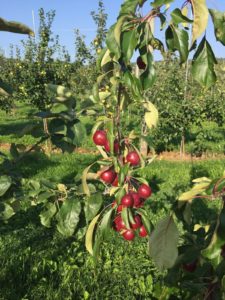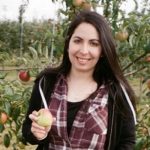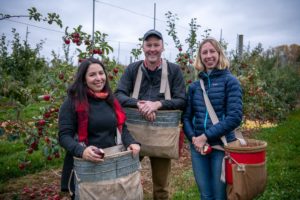 More than 7,500 varieties of apples grow across almost every region on the planet. With growing threats to global food security, they’re affordable, packed full of vitamins, and an excellent source of fiber. They’re also an industry worth $2 billion each year – in the US alone.
More than 7,500 varieties of apples grow across almost every region on the planet. With growing threats to global food security, they’re affordable, packed full of vitamins, and an excellent source of fiber. They’re also an industry worth $2 billion each year – in the US alone.
That’s why we were so excited to announce our most recent Plant & Animal SMRT Grant winners from Canada’s Apple Diversity Lab within the Faculty of Agriculture at Dalhousie University. In Nova Scotia’s Annapolis Valley, Zoë Migicovsky, Sophie Watts and Tom Davies study the tremendous natural diversity of apples and help breed new varieties which are tasty and require less chemical input to grow. Dr Sean Myles is the lab’s principal investigator.
Together, they’re planning to use the PacBio SMRT Grant to sequence a pangenome to help feed the world’s growing population while fighting climate change.
Recently, we had the opportunity to catch up with them and ask a few questions about who they are and what they do. This is what they had to say:
Sophie, Tom, Zoë – tell us more about yourselves, what is your role in the lab? What interests you most about genomics and The Apple Diversity Lab?
 ZM: I’m Dr. Zoë Migicovsky and I’m a postdoctoral fellow in the Apple Diversity Lab. I’ve been studying apple genomics for over 7 years. Genomics is a powerful tool for quantifying and understanding the amazing variation found in apples, and my goal is to use genomics to help conserve and harness apple diversity.
ZM: I’m Dr. Zoë Migicovsky and I’m a postdoctoral fellow in the Apple Diversity Lab. I’ve been studying apple genomics for over 7 years. Genomics is a powerful tool for quantifying and understanding the amazing variation found in apples, and my goal is to use genomics to help conserve and harness apple diversity.
 TD: My name is Tommy Davies and I am a PhD student working in the Apple Diversity Lab. My role in the lab is to help in the discovery of causal alleles for some key agricultural traits in apple. For example, we are currently looking to identify the genetic variants that control ripening time, softening and phenolic content.
TD: My name is Tommy Davies and I am a PhD student working in the Apple Diversity Lab. My role in the lab is to help in the discovery of causal alleles for some key agricultural traits in apple. For example, we are currently looking to identify the genetic variants that control ripening time, softening and phenolic content.
The seemingly endless possibilities of plant genomics is what interests me. Plants have the ability to do so many amazing things, and these abilities are all secretly coded into the genome. The prospect of solving the mystery controlling each unique plant trait is so exciting. I was drawn to work at Canada’s Apple Biodiversity Collection (ABC) because it is a perfect population for genetic discovery and crop improvement. The ABC is one of the most diverse apple germplasm in the world, and the secrets it holds are countless! Canada’s ABC holds incredible potential for both fundamental biological insights and crop improvement.
 SW: I’m Sophie and I’m a PhD student in the Apple Diversity Lab. What interests me most about plant genomics is that it is the foundation for being able to breed better crops. I love food, and I am concerned about how we will continue to produce delicious and nutritious food in the face of climate change. This is why I was drawn to work with the Apple Biodiversity Lab. We study one of the most important fruit crops and are working to figure out how we can improve apples.
SW: I’m Sophie and I’m a PhD student in the Apple Diversity Lab. What interests me most about plant genomics is that it is the foundation for being able to breed better crops. I love food, and I am concerned about how we will continue to produce delicious and nutritious food in the face of climate change. This is why I was drawn to work with the Apple Biodiversity Lab. We study one of the most important fruit crops and are working to figure out how we can improve apples.
Why did you apply to this year’s SMRT Grant? How will HiFi data for the apple genomes help your overall research goals?
ZM: We are lucky enough to work on one of the most diverse apple orchards in the world, Canada’s Apple Biodiversity Collection, which has over 1,000 unique apple trees. Although we have spent years collecting trait data, we are still lacking when it comes to genomic information. I applied for this year’s SMRT Grant because I wanted to increase the amount of genomic information we have to complement the trait data we have collected.
TD: From a genetics perspective, working with apple is difficult because there is lots of genetic diversity and variation – which is difficult to capture. I applied for this year’s SMRT Grant because Hi-Fi reads offer high quality, long sequencing reads that will help us understand this diverse species and improve our world’s food systems in the future.
SW: I applied for a SMRT Grant because we already have a large amount of trait data collected from our orchard of 1,000 apples. Our phenotype data includes traits like firmness, ripening time and sugar content. The area that is ripe for improvement is our genetic data. HiFi data will help strengthen our genetic data and hopefully allow us to identify variation that is useful for improving apples.
You all applied separately for the SMRT Grant, how will these genomes answer each of your research questions?
 ZM: Although we each applied separately for the SMRT Grant, we are all studying the same orchard, Canada’s Apple Biodiversity Collection, and so the SMRT Grant will benefit each of our research questions by improving genomic resources available for this orchard (and apples in general!). The apple genomes include trees that flower and ripen at different times during the growing season. As the frequency of unpredictable weather events increases, capturing genetic variation across flowering and ripening time will be an essential starting point for combating the effects of climate change and improving apple resilience.
ZM: Although we each applied separately for the SMRT Grant, we are all studying the same orchard, Canada’s Apple Biodiversity Collection, and so the SMRT Grant will benefit each of our research questions by improving genomic resources available for this orchard (and apples in general!). The apple genomes include trees that flower and ripen at different times during the growing season. As the frequency of unpredictable weather events increases, capturing genetic variation across flowering and ripening time will be an essential starting point for combating the effects of climate change and improving apple resilience.
TD: High quality reference genomes are like gold for any genetic investigation. Full genomes created with Hi-Fi reads will help us to accurately “zoom in” on important areas of the genome that we suspect control important traits, like ripening time and nutritional content. By comprehensively cataloguing genetic variation in the most diverse individuals in Canada’s Apple Biodiversity Collection, we will be able to better understand the genetic variants that cause the phenotypes we see in the field.
SW: Our goal is to be able to capture as much genetic variation across apples so we can understand how different traits in apples are controlled. The genomes provided by the SMRT Grant will allow us to uncover new insights into the apple genome and leverage the existing genetic data to identify more variation that underlies key traits in apple.
Sean Myles, tell us more about your lab, orchards, and overall research goals
 SM: My research group has been working on apple genomics research for about a decade now. We’re invested in the long-term endeavour of discovering the desirable genetic variants that will be key to improving apples in the future. It’s an ambitious goal with a 20-year time horizon, but it’s been a lot of fun so far and we are just beginning to see the fruits of our labor.
SM: My research group has been working on apple genomics research for about a decade now. We’re invested in the long-term endeavour of discovering the desirable genetic variants that will be key to improving apples in the future. It’s an ambitious goal with a 20-year time horizon, but it’s been a lot of fun so far and we are just beginning to see the fruits of our labor.
How will the haplotype-resolved pangenomes for the apple help feed future generations and a growing population? How did you choose which apples to sequence?
SM: Haplotype-resolved pangenomes are essential to capture the widespread structural variation that exists among the genomes in our diverse collection of apples. It is likely that many of the causal genetic variants we aim to find can only be identified and properly characterized with the aid of HiFi reads. So, the use of this technology is essential in our ambitious endeavour to improve apples for a future of higher food demands and climate uncertainty. We chose 10 different apple varieties from the 1000+ varieties in our collection using an algorithm that selects the 10 samples that maximizes the number of haplotypes that will be sequenced.
What actionable data are you hoping to find within apple genomes?
SM: Our hope is to identify genetic variants that can be subsequently imputed across our 1000+ varieties. We will then link these data with our extensive phenotypic data to find alleles that are likely causal. We will then follow up on these putatively causal alleles by testing their function either in vitro or in vivo using functional genomics experiments.
Once you obtain these genomes, what comes next?
SM: We are looking forward to quantifying the proportions of the genomes that are shared and dispensable, and to compare these results with other species. In addition, we will determine how well the structural variants we identify can be imputed using our other DNA sequence data, and figure out whether any of these structural variants are associated with phenotypes of interest.
What advice would you give to new researchers looking to do similar research projects? What have you learned over the years in your field?
SM: My advice to new researchers is to think long-term and strategize with a long view of the future. Building a research program involves many small steps along a crooked path. It’s only after years of tinkering, playing and exploring around the periphery of the path that a somewhat unified picture begins to emerge. And even after that picture is clear to you, it will still take an enormous amount of effort to figure out how to effectively communicate that picture to others.
It’s been our privilege to support research which may not otherwise have access to leading-edge genomics technologies, and we are looking forward to seeing how these four scientists revolutionize apple agrigenomics.
Visit our plant and animal genomics page or HiFi sequencing page to learn more about our technology it’s research applications.